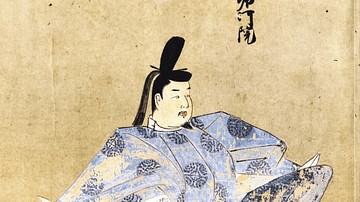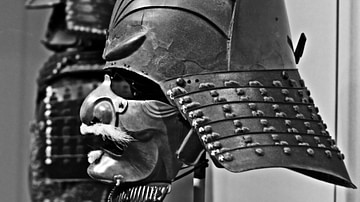Insei or 'cloistered government' describes the strategy of emperors during the late Heian Period (794-1185 CE) in ancient Japan where they abdicated in favour of a chosen heir yet still ruled in some capacity, typically after retiring to a Buddhist monastery, hence the reference to a cloister. The emperors took such measures to guard against themselves and their successor being dominated by the powerful ruling families of the period, especially members of the Fujiwara clan, who sought to place their own supporters on the imperial throne. Although successfully employed by several emperors, two of the unfortunate consequences of the strategy were that the provinces became more remote from government control and the rivalries for power in Japan heightened to such a degree that a greater militarisation of politics eventually led to a complete overthrow of government and long-lasting rule by the shoguns in the medieval period.
Fujiwara Control
During the Heian Period in ancient Japan, government came to be dominated by one extended family clan in particular, the Fujiwara. They managed to monopolise key government positions, marry their daughters to emperors, and in many cases even act as regents and directly control the affairs of state. The Fujiwara were able to usurp the power of the emperor and reduce him to a mere figurehead, not only because they were backed by a powerful private militia when the royal household had no such army to fall back on but also because the Fujiwara purposely selected new emperors while they were still children. Thus the young emperor had to be advised by a regent (Sessho) who was almost always a representative of the Fujiwara family. In total there would be 21 Fujiwara Regents from 804 CE to 1238 CE.
Even when an emperor reached adulthood, he was still advised by a newly created position, the Kampaku, which ensured the Fujiwara maintained their grip on power. To guarantee this situation was perpetuated, new emperors were nominated not by birth but by their sponsors and encouraged or forced to abdicate when in their thirties in favour of a younger successor. Any adult emperor who proved too uncooperative was either forced to abdicate or conveniently removed, sometimes in mysterious circumstances. Thus, for example, between 858 and 956 CE there were 10 different emperors. As a consequence, key Fujiwara members could act as regent to three or four successive emperors in their own lifetime. One such figure was Fujiwara no Yoshifusa (804-872 CE) who was the clan leader (uji nochoja) from 858 CE. He put his seven-year-old grandson on the throne in 858 CE and then formally became his regent in 866 CE. This was the first time a regent had not been of royal blood, and it established a trend that would continue into the 11th century CE.
The Emperors Fight Back
One of the first attempts by the emperors to reassert their power and independence was by Emperor Uda. He sought to break the Fujiwara monopoly by promoting one Sugawara Michizane (845-903 CE), an outsider of lowly social rank, to the high position of Minister of the Right and a member of the Council of State in 899 CE. In 901 CE, the Fujiwara fought back and concocted an accusation of treason against Sugawara with the result that he was effectively exiled. Sugawara would get his revenge when certain disasters befell the palace and state following his death, and ultimately he was even officially deified as the Shinto god Tenjin. Besides the Sugawara case, though, the Fujiwara still maintained their stranglehold on power.
The next challenge came from Emperor Shirakawa (r. 1073-1087 CE) who attempted to assert his independence from the Fujiwara by abdicating in 1087 CE and allowing his son Horikawa to reign under his supervision. Shirakawa's own father, Emperor Go-Sanjo (r. 1068-1073 CE), the first emperor in many reigns not to have a Fujiwara mother, had done exactly the same but had died a year after abdicating. Both ruler's advisors were from the Minamoto clan, and there was no love lost between them and the Fujiwara. The cracks in Japanese politics were beginning to widen.
From his private chambers (in) in a Buddhist monastery, Shirakawa conducted politics (sei) and ruled behind the scenes for over four decades. The strategy of insei or 'cloistered government' was now fully instigated. The concept of an early retirement from one's often hectic social and ceremonial duties was a common enough move for heads of families in ancient Japan (and still is today to some extent). It was known as Inkyo and allowed a family head or a man responsible for an important institution to devote more time to study, religious affairs, and escape the burden of social responsibilities. Therefore, the emperors' strategy of rule from afar was an adoption of an existing tradition for their own political convenience. Free from the burden of largely meaningless ceremonial duties, they could now concentrate on wielding real political power. Shirakawa continued his father's policies of reorganising the provincial estates, placing supporters in the key ministries and in the still influential decision-making body the Council of State, giving lucrative tax collecting rights to supporters, and overseeing the return to the system where emperors appointed governors for a term of four years.
Finally, the emperors had found a way to claw back some of their power and reduce the Fujiwara's use of patronage to sustain their position. The strategy of 'cloistered government', besides escaping the inconsequential ceremonies attached to the throne, also allowed the emperor to remove himself from the political intrigues of the capital and have the freedom to surround himself with his own advisors and not those forwarded by the Fujiwara. The strategy continued with Shirakawa's successors who likewise created their own bureaucracy (the In-no-Cho) similar to that of the Fujiwara clan, creating, in effect, a parallel power structure. The In-no-Cho dealt with tax and land rights related to the throne, and some of its officials even worked in the government bureaucracy too.
Shirakawa's grandson Toba abdicated and ruled in retirement from 1123 to 1156 CE and his son, Go-Toba, did the same, ruling from his cloister between 1158 and 1192 CE. There were, on four occasions, two retired emperors at the same time, but when this happened, one, the first to have retired, was considered the senior retired emperor. The policy of 'cloistered government' was working but it was not a legal and formal substitute to centralised government, and consequently, it was not without its problems. There must also have been a deal of confusion with so many different sources of authority in Japanese government, as the historian G. Cameron Hurst III here summarises,
…sovereignty remained largely with the emperor - if for no other reason than that there had to be an emperor, while an abdicated emperor was not a political necessity…[in some cases] there was no distinction between the emperor and the retired emperor, and therefore retired emperor documents were equivalent to imperial edicts…[However] there are other documents indicating that for virtually all of the Heian period imperial edicts were, strictly speaking, more authoritative, more orthodox than ex-sovereign documents. But obviously there was uncertainty in many quarters, and the distinction may be clearer to us today than it was then. What historians call the insei was not a legally based system of political control but a more informal order of organization, which sought to utilize the existing political system. (in Whitney Hall, 640)
Problems & Decline
There was a price to pay for the retired emperors' hold on power. Having reorganised and decentralised some elements of government, particularly in terms of patronage, both the Fujiwara and the emperor could no longer fully control who had power in the regions. The royal supporters who were given the favours of collecting regional taxes usually never themselves left the capital Heiankyo but deputised the role to local strongmen. The resulting increase in independence from regional and capital affairs led to warlords exploiting the absence of control. Rebellions broke out in the provinces, notably one in 1031 CE led by Taira no Tadatsune, and again in 1051 and 1135 CE. The whole of Japan became gradually more militarised with even Buddhist monasteries fielding their own private armies to protect their landed interests, march on the capital when new unfavourable laws were introduced, and battle with rival monasteries.
Another consequence of cloistered government was the diminishing of a regular tax income from dividing up royal estates to create new tax-free estates (shoen) for loyal followers. There were also the ever-rising costs of the lavish court lifestyle. The double nature of the government apparatus led to aristocrats having to choose which side to support, which only added to the political manoeuvring, treachery, and potential for corruption. All of these factors coupled with the large number of professional warriors in the employment of anyone with political ambitions meant that the government was in serious danger of collapse. Indeed, the end came with the arrival of the Kamakura period (1185-1333 CE) and the dominance of the shoguns. Imperial power once more went into decline following the military defeat of Emperor Go-Daigo (r. 1318-1339 CE), although he himself had already removed his own father from his position of cloistered government in 1321 CE. The military dominated government from now on, and the imperial throne would only see a return to some of its former glory with the Meiji Restoration of 1867 CE.
This content was made possible with generous support from the Great Britain Sasakawa Foundation.







